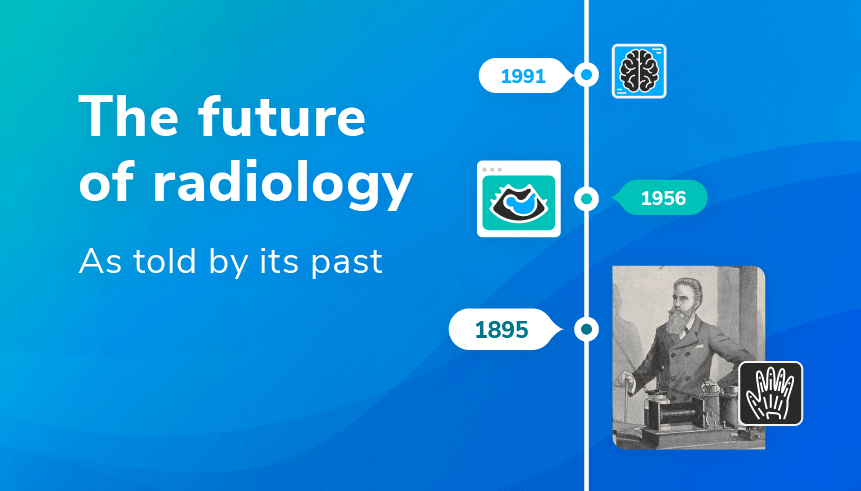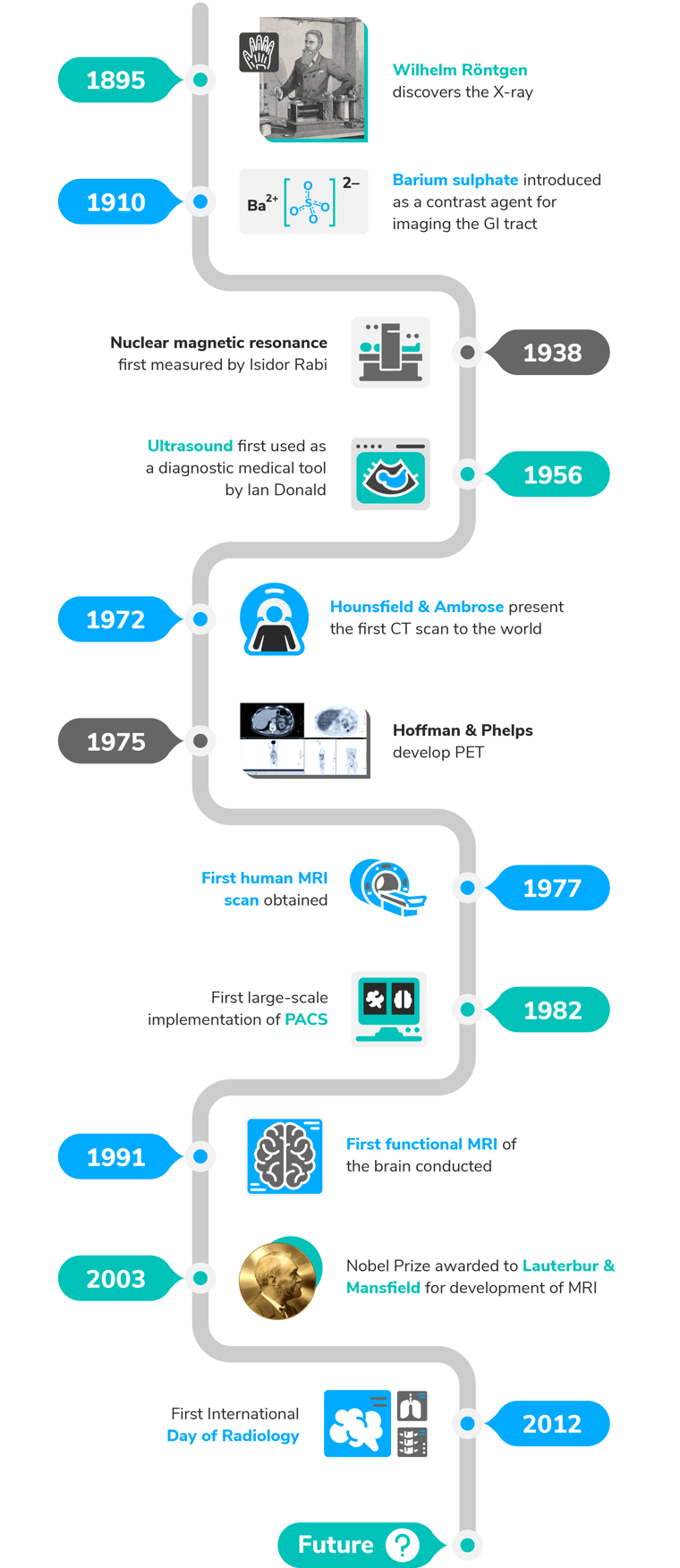Revolutionizing drug development for Parkinson's disease by using imaging biomarkers analysis tools.
It is difficult to diagnose Parkinson’s disease, and the only way to confirm diagnosis is postmortem. The new imaging AI tools could be the answer.
Since the discovery of X-Rays in 1895, Radiology has been evolving rapidly. With 127 years of advancements in mind, what can we expect for its future?

“A new scientific truth does not triumph by convincing its opponents and making them see the light, but rather because its opponents eventually die, and a new generation grows up that is familiar with it.”
Planck’s Principle. An argument for why new scientific theories and methods are often slow to be accepted. Unlike the sluggish adoption of heliocentrism, Darwinian evolution, and continental drift theory, radiology appears to have rarely followed suit. The field of radiology was born out of a paradigm shift: the discovery of the X-ray. It took very little for X-rays to capture mass scientific and societal interest, in part due to their undeniable practical applications. It set the tone for radiology as a rapidly evolving scientific discipline. So with this and 127 years of advancements in mind, what can we expect for its future?
X-ray hysteria… AI hysteria?
When, in December 1895, Planck’s contemporary and Father of Radiology, Wilhelm Röntgen, handed over his findings to his secretary, it is hard to believe he could have predicted the full extent of their impact. But Röntgen’s famous words, “now, all hell can break loose”, were prophetic after all. X-rays were a scientific success: 1,044 papers on the topic were published in 1896, from physics and medicine to microbiology and food. They were also a commercial success. Led by Thomas Edison, public exhibitions were held where attendees could do the unthinkable and see into their bodies. Their ability to reveal the invisible meant X-rays found their way into art, comic books, and even shoe shops. However, this quality was unsettling for some. To name the rays after the unknown quantity ‘X’ perfectly captured the sense of intrigue and fear surrounding them, despite their rapid assimilation into society.
There are parallels between the public awe with which X-rays were initially received and society’s collective apprehension towards artificial intelligence (AI). AI Critics have warned of a similar ‘hellish’ future. When we think of how AI is represented in popular culture, we think of highly advanced robots and a technological singularity. And it’s not total misinformation. In his book The Precipice: Existential Risk and the Future of Humanity, philosopher Toby Ord contemplates a future in which “an ever-increasing share of power is handed over to AI systems” and humans eventually cede control over our destiny. A realistic early step in this would be mass unemployment, and the concern is shared by some radiologists.
However, hypothetical ethical challenges should not overshadow AI’s huge potential. When the British Institute of Radiology (BIR) quizzed presidents of radiological societies from around the world on the future of imaging in 2019, AI was repeatedly touted as a positive development for the field.
AI should not be seen as a replacement for the perceptual expertise of examining a patient scan and making a diagnosis, but rather as an aid to that process. It can assist with the problem of Big Data in the neurosciences and beyond. It can substantially accelerate imaging efficiency, as with deep learning-based image reconstruction technologies. Ultimately, it will allow time spent with the patient to be more fruitful. The most pressing issue for radiologists in this respect is the use of unrepresentative, low-quality datasets in developing these technologies.
Radiology is the very quintessence of technology’s transformative effect on medical practice. Few fields are better placed to benefit from it, and so, as in the past, new developments should be embraced in the face of public trepidation.
CT: a case for multidisciplinary science
Computed tomography (CT) was another technological triumph in the history of radiology. Although radiography equipment underwent steady improvements in the early 20th century, X-rays remained poor at imaging soft tissues such as the vascular system and the brain. Contrast media (e.g. barium sulfate) were introduced as a solution to this, but were not without (potentially life-threatening) side effects. X-ray research seemed to have hit a wall.
This all changed at the 1972 Congress of the BIR following Sir Godfrey Hounsfield and Dr. James Ambrose’s presentation: ‘Computerized Axial Tomography’. Using their prototype scanner - a rotating X-ray source, sensors, and computer-, they reconstructed for the first time an image of a brain tumor in the frontal lobe without a contrast agent. Being computer-based rather than film-based, CT enabled clinicians to visualize tissues of interest at a greater magnification and through various planes. It has since proved indispensable in the clinic for everything from image-guided surgery to radiotherapy planning.
The fascinating thing about CT is that Hounsfield was not the first to conceptualize it. It was envisioned in one of the very first articles to break the news of X-rays to the world in January 1896. The Frankfurter Zeitung spoke of “perfecting the method” so that “only parts of the soft tissue remain transparent” to “expose a deeper slice”. This was not your average newspaper, as it was later one of the few media outlets to not be completely controlled by the Ministry of Propaganda in Nazi Germany. Then, in 1922, a patent application was filed for the process of tomography by Bocage. His invention involved synchronous movement of the X-ray tube and plate, enabling the blurring of structures above and below a section of interest. Even Hounsfield himself - an electronics and radar man at heart with significant contributions in the computer field - did not originally conceive of the idea with medicine in mind. He was instead investigating pattern recognition, working under the hypothesis that with sufficient measurements of the exterior of a box, you should be able to work out what’s inside.
What can we take away from this for the future? It teaches us that the breakthrough technologies of the future, or at least the seed of an idea, may already exist. That the boundaries between scientific disciplines are where the magic happens. Radiologists must be equipped to nurture a widening skill-set and be cross-disciplinary thinkers, able to understand the patient as a clinician and the machines as an engineer. They have to not only learn but also innovate, and at the very least, effectively collaborate.
Whether this is tangible is a different question. Radiology departments across the world are battling a lack of resources. In developed countries, this reveals itself as a shortage of radiologists. In economically developing countries or those with extensive rural populations, unequal access to imaging technologies is a challenge, much less the latest advances. It may be that additional interdisciplinary training is not exactly at the top of many departments’ priorities.
Increasing objectivity of the discipline
In the BIR’s society survey, the Radiological Society of South Africa had an interesting take: “Radiology will transform from a subjective perceptual skill into an objective science.” Radiology has been moving on this path for some time, but has started to speed up with the advent of magnetic resonance imaging (MRI), in particular the emerging field of quantitative MRI (qMRI).
qMRI goes beyond visual detection of macroscopic tissue pathology and considers intrinsic tissue properties such as longitudinal and transverse relaxation times, susceptibility, axon myelination, and iron deposition. There is a great deal of research going into the development of MRI biomarkers that are both sensitive and specific to certain pathologies. Researchers are working towards complete characterization of abnormal tissues using, for example, probability maps constructed from both imaging and non-imaging information. This would circumvent the ambiguity and human error that come with manual data reviews and, ideally, the need for biopsies when making a definitive diagnosis. It comes leaps and bounds from the qualitative interpretations of the very first X-ray photographs.
Despite the abundance of quantitative tools in active research, their integration in the clinic has a long way to go. Currently, to truly extract the most from all the information MRI has to offer, data acquisition could take hours. There is also the challenge of analyzing potentially vast quantities of data in a hospital setting. Even then, the MRI community is plagued by reproducibility and repeatability issues that could compromise a clinician’s decisions thereafter.
The near future, therefore, requires a hybrid approach as this transformation happens. We can expect qMRI to integrate with information from molecular imaging and genomics. Longer term, quantitative tools will forge the path towards precision medicine.
The meteoric rise of the radiology department
If hospitals were an organism, and each department a physiological system, radiology would be the CNS. Radiologists are a pivotal part of the modern multidisciplinary hospital team. Demand for imaging examinations is soaring. In 2018, the Royal College of Radiologists estimated a 48% increase in hospital MRI scans over the previous five years. In the future, we can hope to see this rise increasingly reflected in clinical trials.
Imaging is already widely used in clinical trials. The FDA has put out several guidelines for implementing imaging in clinical trials since first opening the door in 1997. Accordingly, Medpace estimates that imaging technologies are needed in some capacity by 50% of trials. By 2030, the global clinical trial imaging market is expected to be valued at almost 2 billion US dollars.
If this seems like a high cost to sponsors, it is important to point out that medical imaging reduces study costs in the long term. From identifying patients most likely to benefit from an intervention to the potential for early outcome detection, including imaging, can increase the probability of success in a market that is otherwise struggling, as you can read in this article about how Neuroimaging Based Clinical Trials are Failing.
QMENTA is leading the charge in facilitating radiology’s future. With access to our AI-powered platform and integrated quantitative tools just a computer and internet connection away, we are working hard to cement imaging as a mainstay in clinical trials and ensure the accessibility of breakthrough technologies all over the world.

References:
Bocage AEM (1921) Procede et dispositifs de radiographie sur plaque en mouvement [Moving plate radiography process]. French Patent No. 536,464 (in French)
Gulani, Vikas & Seiberlich, Nicole. (2020). Quantitative MRI: Rationale and Challenges. 10.1016/B978-0-12-817057-1.00001-9. Ord, T. (2020). The precipice : existential risk and the future of humanity. Bloomsbury Publishing. ESR (European Society of Radiology), ISHRAD (International Society for the History of Radiology) . (2012). The Story of Radiology. Available: http://www.bshr.org.uk/The_Story_of_Radiology_Vol1.pdf The British Institute of Radiology(2019) .The Global Future of Imaging. Available: https://www.bir.org.uk/media/408496/the_global_future_of_imaging_a4_24pp-hr.compressed.pdf Imaging Technology News (ITN) (2022).GE Healthcare’s AIR Recon DL Receives FDA Clearance of 3D and Motion-Insensitive Imaging Applications for Next-Level Image Quality and Patient Experience in MRI. Available: https://www.itnonline.com/content/ge-healthcare%E2%80%99s-air-recon-dl-receives-fda-clearance-3d-and-motion-insensitive-imaging The Royal College of Radiologists (RCR). (Last revision 2020) Clinical radiology UK workforce census report 2018. Available: https://www.rcr.ac.uk/publication/clinical-radiology-uk-workforce-census-report-2018 Chergova, M. (2021). Infographic: The Key Role of Imaging in Clinical Trials. Labiotech.eu. Available: https://www.labiotech.eu/infographics/role-medical-imaging-techniques-clinical-trials/ Grand View Research, INC. (2022). Clinical Trial Imaging Market Size Worth $1.97 Billion By 2030: Grand View Research, Inc. CS PR Newswire. Available: https://www.prnewswire.com/news-releases/clinical-trial-imaging-market-size-worth-1-97-billion-by-2030-grand-view-research-inc-301537114.html 
It is difficult to diagnose Parkinson’s disease, and the only way to confirm diagnosis is postmortem. The new imaging AI tools could be the answer.
Unleashing automated white matter lesion segmentation: Advancements in MS assessment. Evolving imaging techniques, revolutionizing diagnosis &...
Discover insights into structural and functional aspects of the human brain, potential biomarkers, and applications in psychiatric research.